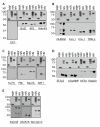Host proteins interacting with the Moloney murine leukemia virus integrase: multiple transcriptional regulators and chromatin binding factors
- PMID: 18554410
- PMCID: PMC2481268
- DOI: 10.1186/1742-4690-5-48
Host proteins interacting with the Moloney murine leukemia virus integrase: multiple transcriptional regulators and chromatin binding factors
Abstract
Background: A critical step for retroviral replication is the stable integration of the provirus into the genome of its host. The viral integrase protein is key in this essential step of the retroviral life cycle. Although the basic mechanism of integration by mammalian retroviruses has been well characterized, the factors determining how viral integration events are targeted to particular regions of the genome or to regions of a particular DNA structure remain poorly defined. Significant questions remain regarding the influence of host proteins on the selection of target sites, on the repair of integration intermediates, and on the efficiency of integration.
Results: We describe the results of a yeast two-hybrid screen using Moloney murine leukemia virus integrase as bait to screen murine cDNA libraries for host proteins that interact with the integrase. We identified 27 proteins that interacted with different integrase fusion proteins. The identified proteins include chromatin remodeling, DNA repair and transcription factors (13 proteins); translational regulation factors, helicases, splicing factors and other RNA binding proteins (10 proteins); and transporters or miscellaneous factors (4 proteins). We confirmed the interaction of these proteins with integrase by testing them in the context of other yeast strains with GAL4-DNA binding domain-integrase fusions, and by in vitro binding assays between recombinant proteins. Subsequent analyses revealed that a number of the proteins identified as Mo-MLV integrase interactors also interact with HIV-1 integrase both in yeast and in vitro.
Conclusion: We identify several proteins interacting directly with both MoMLV and HIV-1 integrases that may be common to the integration reaction pathways of both viruses. Many of the proteins identified in the screen are logical interaction partners for integrase, and the validity of a number of the interactions are supported by other studies. In addition, we observe that some of the proteins have documented interactions with other viruses, raising the intriguing possibility that there may be common host proteins used by different viruses. We undertook this screen to identify host factors that might affect integration target site selection, and find that our screens have generated a wealth of putative interacting proteins that merit further investigation.
Figures





Similar articles
-
Transcription factor YY1 interacts with retroviral integrases and facilitates integration of moloney murine leukemia virus cDNA into the host chromosomes.J Virol. 2010 Aug;84(16):8250-61. doi: 10.1128/JVI.02681-09. Epub 2010 Jun 2. J Virol. 2010. PMID: 20519390 Free PMC article.
-
Molecular mechanisms of retroviral integration site selection.Nucleic Acids Res. 2014;42(16):10209-25. doi: 10.1093/nar/gku769. Epub 2014 Aug 21. Nucleic Acids Res. 2014. PMID: 25147212 Free PMC article.
-
Integrase-specific enhancement and suppression of retroviral DNA integration by compacted chromatin structure in vitro.J Virol. 2004 Jun;78(11):5848-55. doi: 10.1128/JVI.78.11.5848-5855.2004. J Virol. 2004. PMID: 15140982 Free PMC article.
-
Integration site selection by retroviruses.AIDS Rev. 2004 Jan-Mar;6(1):13-21. AIDS Rev. 2004. PMID: 15168737 Review.
-
Molecular genetics and target site specificity of retroviral integration.Adv Genet. 2001;43:33-69. doi: 10.1016/s0065-2660(01)43003-3. Adv Genet. 2001. PMID: 11037298 Review.
Cited by
-
Retroviral integrase: Structure, mechanism, and inhibition.Enzymes. 2021;50:249-300. doi: 10.1016/bs.enz.2021.06.007. Epub 2021 Aug 23. Enzymes. 2021. PMID: 34861940 Free PMC article.
-
Functional coupling between HIV-1 integrase and the SWI/SNF chromatin remodeling complex for efficient in vitro integration into stable nucleosomes.PLoS Pathog. 2011 Feb 10;7(2):e1001280. doi: 10.1371/journal.ppat.1001280. PLoS Pathog. 2011. PMID: 21347347 Free PMC article.
-
From promoting to inhibiting: diverse roles of helicases in HIV-1 Replication.Retrovirology. 2012 Sep 28;9:79. doi: 10.1186/1742-4690-9-79. Retrovirology. 2012. PMID: 23020886 Free PMC article. Review.
-
Dynein Regulators Are Important for Ecotropic Murine Leukemia Virus Infection.J Virol. 2016 Jul 11;90(15):6896-6905. doi: 10.1128/JVI.00863-16. Print 2016 Aug 1. J Virol. 2016. PMID: 27194765 Free PMC article.
-
Gammaretroviral vectors: biology, technology and application.Viruses. 2011 Jun;3(6):677-713. doi: 10.3390/v3060677. Epub 2011 Jun 3. Viruses. 2011. PMID: 21994751 Free PMC article. Review.
References
-
- Brown P. Integration. In: Coffin J, Hughes SH, Varmus HE, editor. Retroviruses. Cold Spring Harbor, NY , Cold Spring Harbor Laboratory Press; 1997. pp. 161–204.
Publication types
MeSH terms
Substances
Grants and funding
LinkOut - more resources
Full Text Sources

